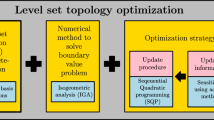Abstract
The two main objectives of virtual assembly are: (1) to train assembly-operators through virtual assembly models, and (2) to simultaneously evaluate products for ease-of-assembly. The focus of this paper is on developing computational techniques for virtual assembly of thin deformable beam and plate-like objects. To meet the objectives of virtual assembly, the underlying computational technique must: (1) be carried out at a high frame-rate (>20 frames/second), (2) be accurate (<5% error in deformation and force estimation), (3) be conducive to collision detection, and (4) support rapid design evaluations. We argue in this paper that popular computational techniques such as 3-D finite element analysis, boundary element analysis and classic beam/plate/shell analysis fail to meet these requirements. We therefore propose a new class of dual representation techniques for virtual assembly of thin solids, where the geometry is retained in its full 3-D form, while the underlying physics is dimensionally reduced, delivering: (1) high computational efficiency and accuracy (over 20 frames per second with <1% deformation error), and (2) direct CAD model processing, i.e., the CAD model is not geometrically simplified, and 3-D finite element mesh is not generated. In particular, a small-size stiffness matrix with about 300 degrees of freedom per deformable object is generated directly from a coarse surface triangulation, and its LU-decomposition is then exploited during real-time simulation. The accuracy and efficiency of the proposed method is established through numerical experiments and a case study.





















Similar content being viewed by others
References
Antonya C, Talaba D (2007) Design evaluation and modification of mechanical systems in virtual environment. Virtual Real 11:275–285
Becker AA (1992) The boundary element method. McGraw-Hill, New York
Brooks FP (1999) What’s real about virtual reality? IEEE Comput Graph Appl 19(6):16–27
Brough JE, Schwartz M, Gupta SK, Anand DK, Kavetsky R, Pettersen R (2007) Towards the development of a virtual environment-based training system for mechanical assembly operations. Virtual Real 11:189–206
Chapman PM, Wills DPM (2000) An overview of physically-based modelling techniques for virtual environments. Virtual Real 5(3):117–131
Dow J, Byrd DE (1988) The identification and elimination of artificial stiffening errors in finite elements. Int J Numer Methods Eng 26(3):743–762
Ehmann SA, Lin MC (2001) Accurate and fast proximity queries between polyhedra using surface decomposition. In: Computer graphics forum (proceedings of Eurographics)
Golub GH, Van Loan CF (1996) Matrix computations. Johns Hopkins, Baltimore
Hermansen F, Lammertsma AA (1995) Linear dimension reduction of sequences of medical images: I. Optimal inner products. Phys Med Biol 40:1909–1920
Hudson T, Lin M, Cohen J, Gottschalk S, Manocha D (1997) V-COLLIDE: accelerated collision detection for VRML. In: Proceedings of the second symposium on virtual reality modeling language. Monterey, California, USA
Jayaram S, Jayaram U, Wang Y, Lyons K, Hart P (1999) VADE: a virtual assembly design environment. IEEE Comput Graph Appl 19(6):44–50
Jemielita G (1990) On kinematical assumptions of refined theories of plates: a survey. J Appl Mech Trans ASME 57:1088–1091
Jorabchi K, Suresh K (2009) Nonlinear algebraic reduction for snap-fit simulation. J Mech Des 113(6)
Kreyszig E (1999) Advanced engineering mathematics, 8th edn. Wiley, New York
Lawrence Associates Inc (1994) Virtual manufacturing technical workshop. Dayton, OH, 25–26 October 1994
Lee JA, Verleysen M (2007) In: Jordan M, Kleinberg J, Scholkopf B (eds) Nonlinear dimensionality reduction. Information science and statistics, vol 18. Springer
Lee KY, Armstrong CG, Price MA, Lamont JH (2005) A small feature suppression/unsuppression system for preparing B-Rep models for analysis. In: Proceedings of the ACM symposium on solid and physical modeling. ACM, Cambridge, Massachusetts
Long Y-Q et al (1995) Generalized conforming plate bending elements using point and line compatibility conditions. Comput Struct 54(4):717–723
Mikchevitch A, Leon JC, Gouskov A (2003) Numerical modeling of flexible components for assembly path planning using a virtual reality environment. In: Proceedings of DETC ‘03, ASME 2003 design engineering technical conferences and computers and information in engineering conference, Chicago, Illinois, USA, Sept 2–6
Mikchevitch A, Leon JC, Gouskov A (2004) Flexible beam part manipulation for assembly operation simulation in a virtual reality environment. ASME Int J Comput Inf Sci Eng 4(2):114–123
Mobley AV, Carroll MP, Canann SA (1998) An object oriented approach to geometry defeaturing for finite element meshing. In: 7th international meshing roundtable. Sandia National Labs, Dearborn, Michigan
Möller T (1997) A fast triangle-triangle intersection test. J Graph Tools 2(2):25–30
Novint Technologies (2007) Novint Falcon: 3D game controller. www.novint.com
Pilkey W (2002) Analysis and design of elastic beams. Wiley, New York
Rathod HT, Govinda Rao HS (1998) Integration of trivariate polynomials over linear polyhedra in euclidean three-dimensional space. J Aust Math Soc 39:355–385
Reissner E (1985) Reflections on the theory of elastic plates. Appl Mech Rev 38:1453–1464
Ribelles J, Heckbert PS, Garland M, Stahovich T, Srivastava V (2001) Finding and removing features from polyhedra. In: 2001 ASME design engineering technical conference. Pittsburg, PA, USA
Shames IH, Dym CL (1985) Energy and finite element methods in structural mechanics. Hemisphere, New York
Taylor RL, Govindjee S (2004) Solution of clamped rectangular plate problems. Commun Numer Methods Eng 20:757–765
Timoshenko S, Krieger SW (1959) Theory of plates and shells, 2nd edn. McGraw-Hill, New York
Wang CM, Reddy JN, Lee KH (2000) Shear deformable beams and plates: relationship to classical solutions. Elsevier, London
Wilson A, Larsen E, Manocha D, Lin MC (1999) IMMPACT: a system for interactive proximity queries on massive models. In: Computer graphics forum (proceedings of Eurographics)
Yang HTY, Saigal S, Masud A, Kapania RK (2000) A survey of recent shell finite element. Int J Numer Methods Eng 47(1–3):101–127
Zhao W, Madhavan V (2006) Virtual assembly operations with grasp and verbal interaction. In: Proceedings of the 2006 ACM international conference on virtual reality continuum and its applications
Zienkiewicz OC, Taylor RL (2005) The finite element method for solid and structural mechanics, 6th edn. Elsevier, Amsterdam
Author information
Authors and Affiliations
Corresponding author
Rights and permissions
About this article
Cite this article
Mishra, V., Suresh, K. A dual-representation strategy for the virtual assembly of thin deformable objects. Virtual Reality 16, 3–14 (2012). https://doi.org/10.1007/s10055-009-0143-0
Received:
Accepted:
Published:
Issue Date:
DOI: https://doi.org/10.1007/s10055-009-0143-0




